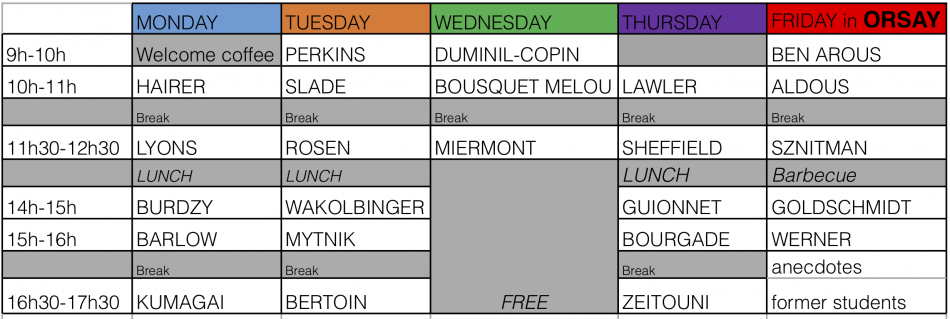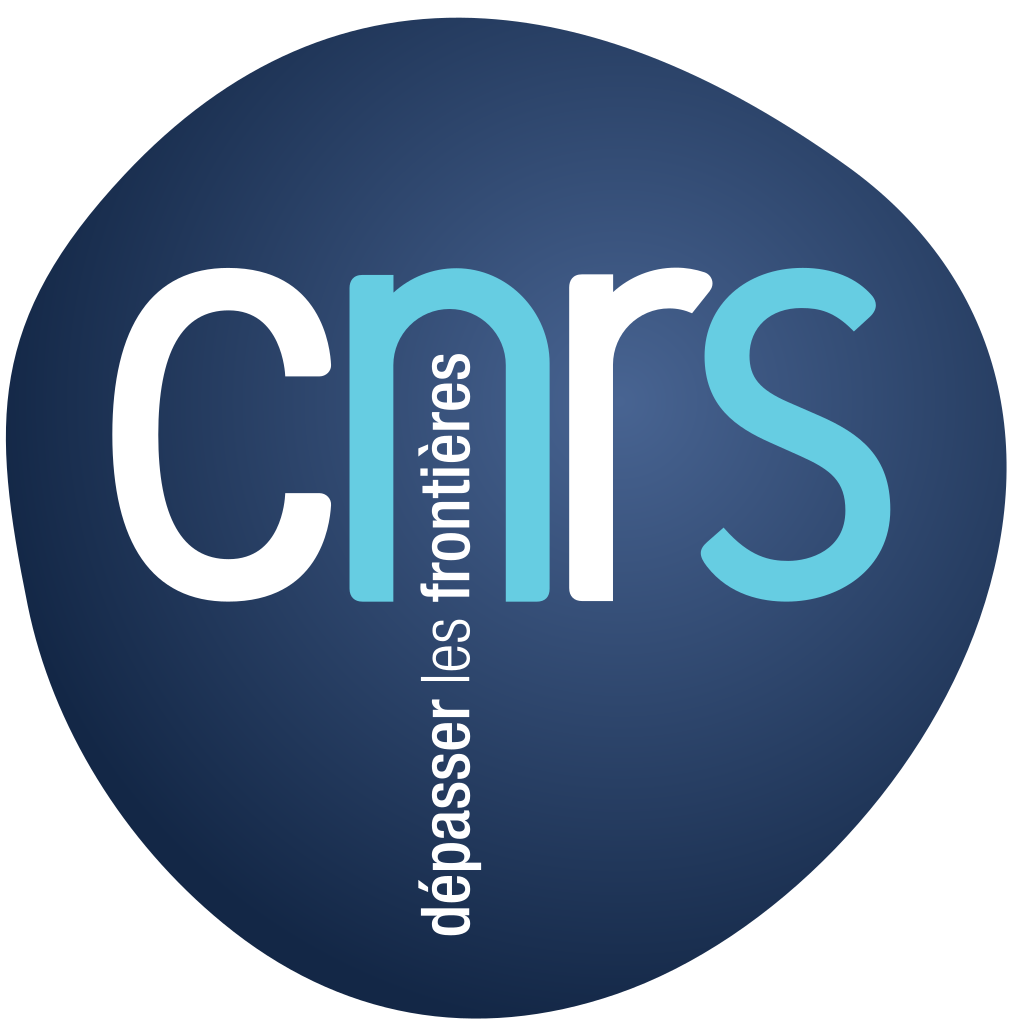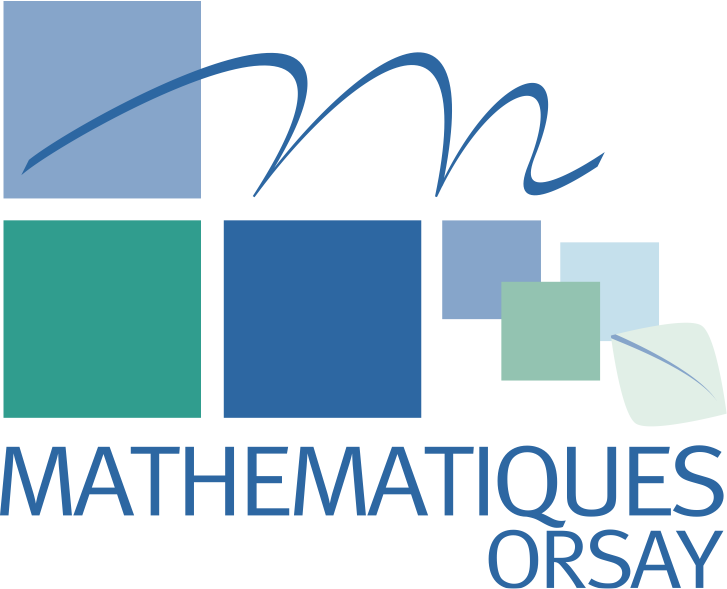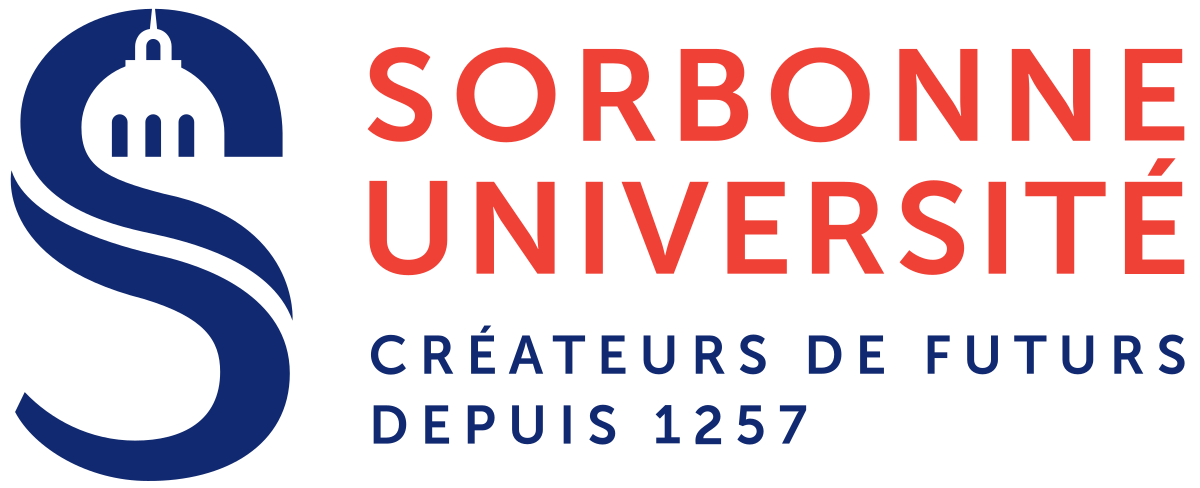David Aldous (Berkley) : Random networks embedded in the plane
Work of Jean-François Le Gall, Gregory Miermont and many others has created a theory of random planar maps that is elegant, mathematically deep and surprisingly well-connected with other areas of mathematics and physics. In that theory, a map is an isomorphism class of networks. In contrast, toy models of real-world networks in the plane with physical links have been little studied within theorem-proof Probability, but have been studied in statistical physics, e.g. the recent monograph « Morphogenesis of Spatial Networks » by Marc Barthelemy. I will talk about work of mine and others over the last 10 years seeking to bridge the gap.
Martin Barlow (UBC) : Heat kernel on the two dimensional UST
Abstract : TBA
Gérard Ben Arous (Courant) : A beautiful animal in the Brownian zoo : The BISE (the Brownian motion on the SuperBrownian Excursion)
Abstract :
I will review a long term joint work with Manuel Cabezas and Alexander Fribergh and the recent progress in the understanding of the phenomenon of anomalous slow diffusion induced by disorder.
We want to focus on the most central class of such examples, i.e. random walks on critical random structures, for instance critical percolation clusters. This question is also known as “the ant in the labyrinth” problem, after Pierre Gilles de Gennes in the 70’s. We study it in high enough dimension, and aim at a detailed understanding of the scaling limit. The proper scaling was predicted in the 80’s and has been known as the Alexander-Orbach conjecture until 2008, when it was proved by G. Kozma and A. Nachmias. But the process arising as a scaling limit has been identified recently as the BISE. I will survey recent progress towards proving that the BISE is indeed the scaling limit for a widening class of critical models in high dimensions.
Jean Bertoin (Zürich) : Branching-stable point measures and processes
* based on a joint work with Aser Cortines (University of Zurich) and Bastien Mallein (Université Paris 13).
We introduce and study the class of branching-stable point measures, which can be seen as an analog of stable random variables when the branching mechanism for point measures replaces the usual addition. In contrast with the classical theory of stable (L\’evy) processes, there exists a rich family of branching-stable point measures with \emphnegative scaling exponent, which can be described as certain Crump-Mode-Jagers branching processes. We investigate the asymptotic behavior of their cumulative distribution functions, that is, the number of atoms in $(-\infty, x]$ as $x\to \infty$, relying crucially on the work of Biggins.
Paul Bourgade (Courant) : Branching processes in random matrix theory and analytic number theory
Abstract : Fyodorov, Hiary and Keating have conjectured that the maximum of the characteristic polynomial of random matrices behaves like extremes of log-correlated Gaussian fields. This allowed them to predict the size of local maxima of L-function along the critical axis. I will explain the origins of this conjecture and outline the proof for the leading order of the maximum, for unitary random matrices and the Riemann zeta function. These results rely on underlying branching structures, and were obtained in collaboration with Arguin, Belius, Radziwill and Soundararajan.
Mireille Bousquet-Mélou (Bordeaux) : Eulerian orientations and the 6-vertex model on planar maps
Abstract : Beyond the combinatorial and probabilistic study of planar maps per
se, many authors have considered planar maps equipped with some
additional structure : for instance proper colourings or spanning trees in the sixties
and seventies, or models of statistical physics since the eighties.
Of course, much less is known on such models than on
« pure » maps. In many cases, even the enumeration of such structures is
an open problem.
I will focus in this talk on orientations of
planar maps that are Eulerian : this means that at every vertex, as
many edges come in and out. On 4-valent maps, this is the so-called
ice model, or 6-vertex model. I will survey recent enumerative results
obtained in a joint work with Andrew Elvey-Price.
Krzysztof Burdzy (Univ. Washington) : On Archimedes’ principle and Fermi acceleration
Abstract : I will describe an approach to Archimedes’ principle using classical mechanics, mixed with some stochastic ideas. « Fermi acceleration » refers to the unlimited growth of energy in models for particles reflecting from moving walls. I will discuss the question of the emergence of Fermi acceleration in rotating drums with hard balls under gravitation.
Joint work with M. Duarte, C.E. Gauthier, R. Graham, J. Malecki
and J. San Martin.
Hugo Duminil-Copin (IHES & Geneva) : Marginal triviality of the scaling limits of critical Ising and φ^4 models in 4D
Abstract : The question of constructing a non-Gaussian field theory, i.e. a field with non-zero Ursell functions, is at the heart of Euclidean (quantum) field theory. While non-triviality results in d<4 and triviality results in d>4 were obtained in famous papers by Glimm, Jaffe, Aizenman, Frohlich and others, the crucial case of dimension 4 remained open. In this talk, we show that any continuum $\phi^4$ theory constructed from Reflection Positive lattice $\phi^4 $ or Ising models is inevitably free in dimension 4. The proof is based on a delicate study of intersection properties of a non-Markovian random walk appearing in the random current representation of the model. This is based on joint work with Michael Aizenman.
Martin Hairer (Imperial) : Reconciling Itô and Stratonovich
Abstract : We all know that SDEs admit two notions of solutions that each come with their own distinct set of symmetries. Stratonovich solutions are equivariant under changes of variables while Itô solutions satisfy Itô’s isometry. We also know that these two symmetries are mutually exclusive. Surprisingly, it turns out that there is a natural class of SPDEs for which there exists a notion of solution that exhibits both of these symmetries simultaneously.
Takashi Kumagai (RIMS, Kyoto) : Stability of heat kernel estimates and parabolic Harnack inequalities for symmetric Dirichlet forms
Abstract : We consider symmetric Dirichlet forms that consist of strongly local (diffusion) part and non-local (jump) part on a metric measure space. Under general volume doubling condition and some mild assumptions on scaling functions, we establish stability of two-sided heat kernel estimates in terms of Poincar\’e inequalities, jumping kernels and generalized capacity inequalities. We also discuss characterizations of the associated parabolic Harnack inequalities. Our results apply to symmetric diffusions with jumps even when the underlying spaces have walk dimensions larger than 2. This is a joint work with Z.Q. Chen (Seattle) and J. Wang (Fuzhou).
Greg Lawler (Chicago) : Fractals in the Brownian zoo
I will give a survey on exceptional points in paths of Brownian motion and the Schramm-Loewner evolution (SLE) with an emphasis on fractal properties (Hausdorff dimension and Minkowski content) and relations to critical phenomena.
Grégory Miermont (ENS Lyon) : Brownian surfaces
We show that uniform random quadrangulations with boundaries on a given compact orientable surface converge after a suitable renormalization to limiting metric spaces, which we call the (compact, orientable) « Brownian surfaces ». This result is obtained by decomposing the quadrangulations along certain geodesics into elementary pieces, for which the convergence can be deduced from the known convergence of plane quadrangulations to Brownian surfaces of genus 0 (sphere, disk, plane and half-plane). Time allowing, we will further discuss some properties of the cylinder (genus 0, two boundaries). Based on joint work with Jérémie Bettinelli.
Leonid Mytnik (Technion) : On the speed of a front for stochastic reaction-diffusion equations
Abstract : We study the asymptotic speed of a random front for solutions to
stochastic reaction-diffusion equations with strong multiplicative noise proportional to $\sigma$.
We show existence of the speed of the front and derive its asymptotics as $\sigma$ goes to infinity.
Ed Perkins (UBC) : On the boundary of Super-Brownian Motion
Abstract : TBA
Jay Rosen (City Univ. New York) : Limit theorems for permanental sequences
Abstract : Permanental processes can be thought of as generalizations of Gaussian squares. They play the role of
Gaussian squares in Isomorphism theorems for non-symmetric Markov processes. We describe a large variety of
limit theorems for permanental sequences which parallel those for Gaussian sequences.
Gordon Slade (UBC) : Three-dimensional tricritical spins and polymers
Abstract : We construct the tricritical point for a model of n-component continuous spins with phi^6 interaction on the 3-dimensional integer lattice. We do the same for a supersymmetric version of the model, where the tricritical point is the so-called theta point for polymer collapse. In both cases, we prove that the tricritical two-point function has Gaussian decay, namely |x|^-1. The proof uses a rigorous renormalisation group analysis. This is joint work with Roland Bauerschmidt and Martin Lohmann.
Scott Sheffield (MIT) Smooth planar maps and Laplacian determinants
Suppose that M is a smooth two dimensional Riemannian surface
(possibly higher genus, possibly with boundary). What probabilistic
meaning can we give to the determinant of the Laplacian on M as it is
traditionally defined (i.e., via analytically-continued-zeta-function
black magic) ?
Well, here is one nice answer : if we regularize/truncate appropriately
then the « partition function » of the so called « loop soup » of
intensity c is precisely the Laplacian determinant to the (-c/2)
power. I will discuss some of the classical results (e.g.,
McKean-Singer 1967) that underly the various forms of this statement.
I will next explain some natural ways to approximate an LQG surface of
central charge c by a smooth surface that (for lack of a better term)
we call a « smooth planar map, » We show that weighting a smooth planar
map by its loop soup partition function changes c in precisely the way
one would expect. This allows us to give a precise meaning to the
statement that an LQG surface with parameter c is just a pure LQG
surface decorated by a loop soup of intensity c. I will discuss a
number of consequences of this point of view.
This is joint work with Morris Ang, Minjae Park, and Josh Pfeffer.
Alain-Sol Sznitman (ETH) : On bulk deviations for the local behavior of random interlacements
Abstract : In this talk we will discuss some recent large deviation asymptotics concerning the local behavior of random interlacements on Z^d, d≥3. We will also describe some of the links with previous results concerning macroscopic holes left inside a large box centered at the origin, by the the adequately thickened connected component of the boundary of the box in the vacant sets of random interlacements.
Anton Wakolbinger (Frankfurt) : Brownian excursions and lookdown spaces
We discuss a realizationwise correspondence between a Brownian excursion (conditioned to reach a certain height) and a triple consisting of (1) its local time profile, (2) the so-called lookdown space and (3) a fair coin tossing sequence, where (2) and (3) encode the ordering by height respectively the left-right ordering of the subexcursions. These three components turn out to be independent, with (2) being based on an array of independent Poisson point processes on the real line and (1) giving a time change which makes these Poisson point processes time-homogeneous. By the Ray-Knight theorem, the local time profile (1) is the excursion of a Feller branching diffusion ; thus the metric structure associated with (2) can be seen as representing the genealogy underlying the Feller branching diffusion. Because of the independence of the three components, up to a time change the distribution of this genealogy does not change under a conditioning on the local time profile. In parts the lecture is based on work in progress with Stephan Gufler and Goetz Kersting.
Ofer Zeitouni (Weizmann) : On cover time in 2D
Abstract : I will describe recent progress, and some speculations, concerning the cover time of the two-dimensional sphere by Wiener sausage. In particular, I will emphasize how certain symmetries of the sphere play a role.
Based on joint work with David Belius and Jay Rosen.
Wendelin Werner (ETH) : Brownian beasts hidden in the free fields
Abstract : We will discuss ongoing work about random geometric objects that can be found within a Gaussian Free Field in dimension 2 and higher.











